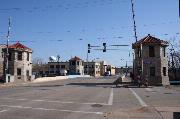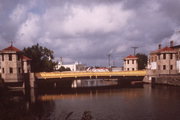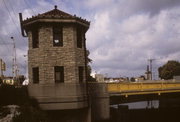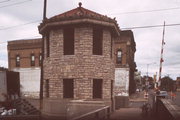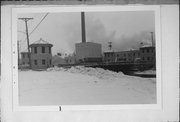Property Record
TAYCO ST
Architecture and History Inventory
| Historic Name: | TAYCO STREET BRIDGE |
|---|---|
| Other Name: | |
| Contributing: | |
| Reference Number: | 27409 |
| Location (Address): | TAYCO ST |
|---|---|
| County: | Winnebago |
| City: | Menasha |
| Township/Village: | |
| Unincorporated Community: | |
| Town: | |
| Range: | |
| Direction: | |
| Section: | |
| Quarter Section: | |
| Quarter/Quarter Section: |
| Year Built: | 1928 |
|---|---|
| Additions: | |
| Survey Date: | 2009 |
| Historic Use: | bridge |
| Architectural Style: | NA (unknown or not a building) |
| Structural System: | Bascule |
| Wall Material: | Metal |
| Architect: | |
| Other Buildings On Site: | |
| Demolished?: | No |
| Demolished Date: |
| National/State Register Listing Name: | Tayco Street Bridge |
|---|---|
| National Register Listing Date: | 5/30/1986 |
| State Register Listing Date: | 1/1/1989 |
| National Register Multiple Property Name: |
| Additional Information: | A 'site file' exists for this property. It contains additional information such as correspondence, newspaper clippings, or historical information. It is a public record and may be viewed in person at the Wisconsin Historical Society, State Historic Preservation Office. The predecessor of the Tayco Street Bridge was a rim-bearing swing bridge with a sixty-foot channel clearance. Routing U.S. Highway 41 over this 19th century bridge necessitated its replacement, but stringent War Department requirements mandated that any new bridge across the canal would have to provide clearance of no less than 100 feet. In 1924 McMahon and Clark Engineering Company of Menasha designed a replacement that met this requirement, utilizing a simple trunnion bascule system and a patented Strauss trunnion. Estimated at an astounding $250,000, the bridge was ultimately funded by the Wisconsin Highway Commission and constructed by Greiling Engineering Company of Green Bay in 1929. The significance of the Tayco Street Bridge is in its architecture. The Tayco Street Bridge is located in the industrial city of Menasha on the principal traffic corridor to Neenah. Spanning the Government Canal at the midpont of its length, the structure is an electrically operated Strauss Trunion bascule bridge. Each bascule pier has a motor, pinion gears, and concrete counterweight below the roadway under twin control towers. The concrete piers are approximately thirty-four feet deep and ninty-two feet wide. The two steel leaves are about fifty-eight feet long and sixty-two feet wide. The steel grated roadway is forty feet wide with eight-foot sidewalks on each side. On each pier stand twin towers, flanking the roadway. The northwest tower serves as a women's restroom, the northeast tower as storage, the southeast tower as the operator's house, and the southwest tower as a men's restroom. The second floor in each tower is unfinished; stairs to the counterweight pits are found in the two eastern towers. Eight feet on a side, each tower is two stories high with a hip roof shingled with red tile. The walls are random coursed limestone and the foundations are concrete. The windows are casement on both the first and second floors, with transoms on the second. Some of these windows have been boarded over. Decorative features include a stone sill course running below the second story windows, and a classically crested terra cotta cornice. Classical handrails and concrete obelisk lamp posts with bronze lanters have been removed. The Tayco Street Bridge is of local architectural significance as a fine example of Period Classical Revival design as applied to bascule bridge construction. The Tayco Street Bridge is distinguished from the other local bridge by its distinctive ornament. The octagonal towers are themselves decorative, serving only nominal functions in the operation of the bridge. The cornice of each is enriched by a bold terra cotta cresting of lions and acanthus leaves, while the red tile roofs provide a rich contrast to grey stone and brown brim. The contemporary Racine Street Bridge includes a bascule lift in its span across the Fox River, but the design is unrelieved by aesthetic considerations. Both bridges replaced 19th century iron bridges with nominal ornament. 2009--Towers still in place. moveable bridge |
|---|---|
| Bibliographic References: | A. Menasha Record; August 31, 1929; Page 1, column 4. |
| Wisconsin Architecture and History Inventory, State Historic Preservation Office, Wisconsin Historical Society, Madison, Wisconsin |

